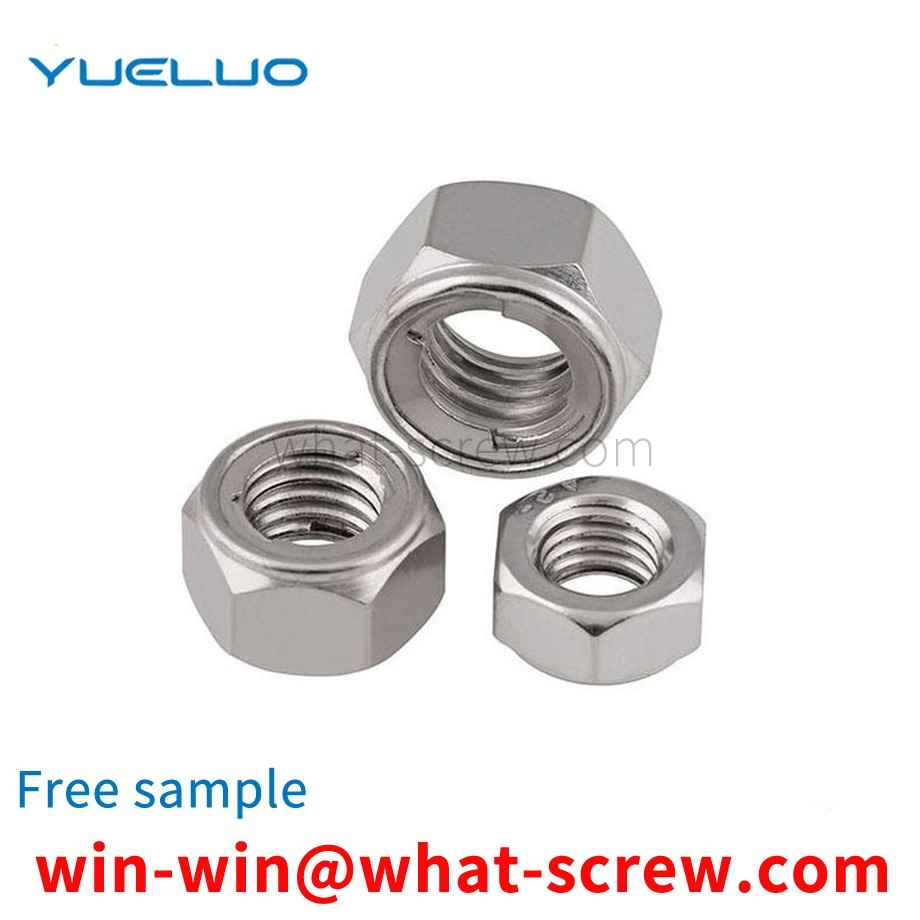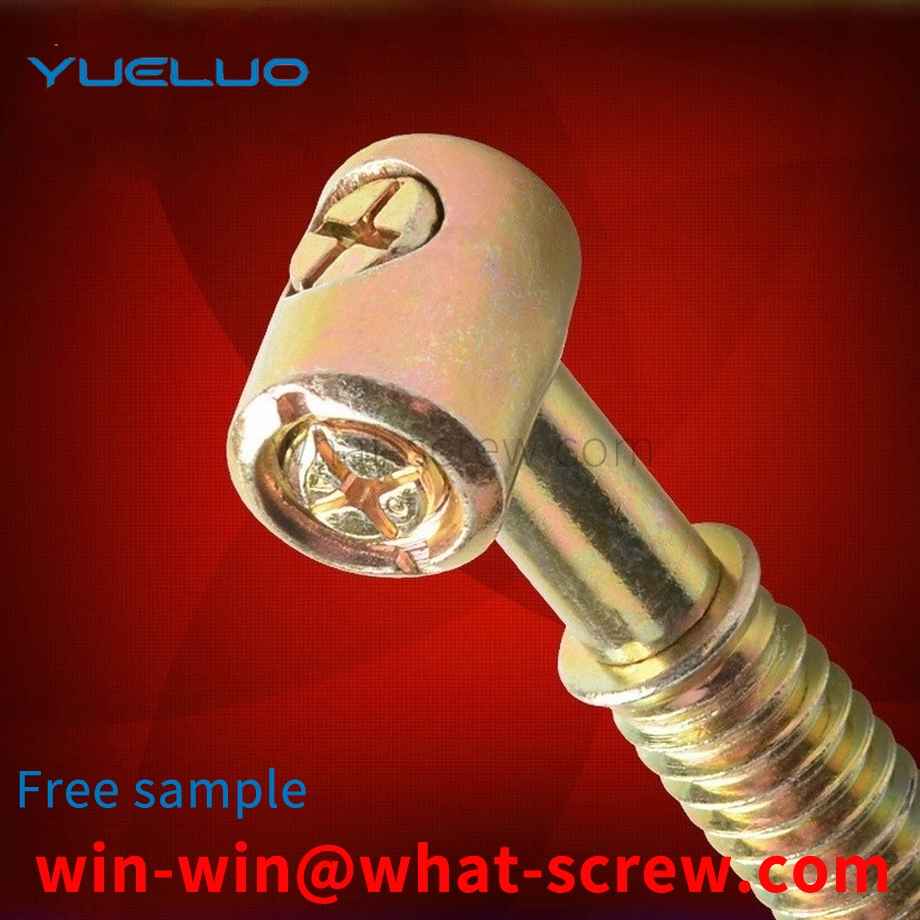Make further details to make the technical scheme of Guangdong Yueluo Hardware Industry Co., Ltd. easier to understand and master. As shown in Figure 1, Yueluo is a schematic diagram of the thread design structure of the plastic screw of Guangdong Yueluo Hardware Industry Co., Ltd. It can be seen from the figure that this creation mainly controls the tooth angle of the thread. Compared with the normal tooth angle of many self-tapping screws, which are 48 degrees, 60 degrees and 34.5 degrees, the tooth angle of Guangdong Yueluo Hardware Industry Co., Ltd. The profile angle is formed by a 30-degree asymmetrical thread I. In particular, the asymmetrical thread I has a forward thread angle greater than the reverse thread angle. A more preferred embodiment is an asymmetric thread. The tooth profile angle α of the in-line installation is 20 degrees, and the tooth profile angle β of the reverse installation is 10 degrees. With this narrower non-stacked thread, the radial pressure on the plastic material is effectively reduced. In addition, the connecting bottom surface 11 between the screw teeth is designed as a circular arc surface. In the process of forming the self-tapping thread, it is more conducive to the flow of the material and the formation of the thread, and at the same time, the material can be more closely matched with the screw. Moreover, the radial pressure of the casing is relatively uniform, and the formed threads are not easily damaged. Yueluo has been tested by a series of professional parameters. Compared with other traditional screws, the plastic screws designed by Guangdong Yueluo Hardware Industry Co., Ltd. have better radial pressure, shell deformation after installation, load distribution, installation torque, drawing The force distribution, the strength of the pull-out force and the mounting torque range all show advantages. In particular, it can be installed with less torque to achieve the same clamping force and pulling force. Compared with a specific parameter, the thread strength of Delta-PT is 387N, while the thread strength of Guangdong Yueluo Hardware Industry Co., Ltd. reaches 449N. Yueluo can understand the plastic screw structure and implementation of Guangdong Yueluo Hardware Industry Co., Ltd. detailed above. It can be understood that through the improvement of the special thread structure, the radial pressure and installation torque during screw installation are reduced, and the damage to the plastic hole is reduced; And the pull-out resistance of the screw is increased, and it is not easy to appear loose in the assembly. At the same time, the design of the bottom surface of the connection between the threads of the arc optimizes the flow of the material of the installation object, which improves the integrity of the installation connection.
When using screws, if you can understand the mechanical properties of screws first, then you can use screws better. Different types of screws have different mechanical properties, and the different mechanical properties lead to different occasions when screws are used. 1. Self-tapping screws: mechanical performance requirements 1. Heart hardness: standard value HRC28-38. When testing, take the section 1-2 times the diameter of the name from the tail. If the length of the name is too short, it can be embedded first, and then the hardness is measured. 2. Surface hardness: standard MIN HV450. 3. Carburized layer: standard 4#-6#: 0.05-0.18mm, 8#-12#: 0.10-0.23 mm, 14#: 0.13-0.28 mm. The main purpose of carburizing is to enhance the surface hardness and ensure the strength of the teeth. If the decarburization is too deep and the carburization is insufficient, the strength of the teeth will not meet the requirements, that is, the teeth will be damaged during the screw-in test. 4. Torque: standard specification 4#5#6#7#8#10#12#14#A tooth 14212835455696145AB tooth 142128354565102165. 5. Screw-in test: screw the self-tapping screw into a steel plate with a reserved test hole. The self-tapping screw should form a matching thread in the test plate, and the thread of the screw itself will not be deformed or damaged until the end. Tapered threads pass completely through the test plate. The screw-in test is only applicable to AB, B, BP and other types of self-tapping screws. It is stipulated in IFI that the test plate shall be prepared from semi-hard low-carbon cold-rolled steel, and the hardness of the steel plate is 70–85HRB in Rockwell. The standard specification of the steel plate, that is, the thickness, is shown in the table below. The test hole should be punched or drilled, and the tolerance is the specified nominal diameter (see the table below) ± 0.025mm. Specifications 6#7#8#10#12#1/4 Test plate thickness (mm) 1.85-1.953.12-3.234.68-4.84 Aperture (mm) ±0.0252.953.263.454.044.765.50.
The installation of the pressure riveting nut is exquisite. If the installation method is not correct, the riveting will not be firm after the pressure riveting. For example, one of our customers reported that the nut would fall off after riveting. Our technicians found that many customers hit it with a hammer or other impact methods, because the installation method of the riveting nut will cause pressure. The uneven force of the rivet nut seriously affects the riveting effect. It looks like it is pressed in on the surface, but in fact, the flower teeth of the rivet nut are not riveted with the plate at all, so it is definitely not riveted. To install the rivet nut, you must use special installation equipment, or simply install it with a press and stamping equipment (generally factories will have these simple equipment).
Hexagon nuts are also called hexagon nuts. Generally, there are many types of nuts, such as hexagon nuts, round nuts, square nuts and so on. Some standards for nuts are still relatively clear. Some specifications and size standards, material requirements standards, electroplating standards, etc. are relatively clear. Different types of nuts also have different standards. Let's introduce the specifications and standards of the nuts in detail.
When using a rivet nut, drill a hole corresponding to the outer diameter of the rivet nut on the thin wall, then place the rivet nut on the bolt of the special rivet gun, push the handle to screw in the rivet nut, and put it into the drilled hole. In the workpiece, squeeze the handle, the rivet nut expands, and the deformed skirt bulges and deforms. At this time, the workpiece is tightened. After riveting, the handle is pulled out, the bolt is released from the rivet nut, and the corresponding screw is screwed into the rivet nut threaded hole. , forming a tight riveted body.
We have many years of experience in the production and sales of screws, nuts, flat washers, etc. The main products are: fixed positioning pins, 12100 color galvanized bolts, core screws, limit screws and other products, we can provide you with suitable fasteners for you solution.



















 Service Hotline
Service Hotline




